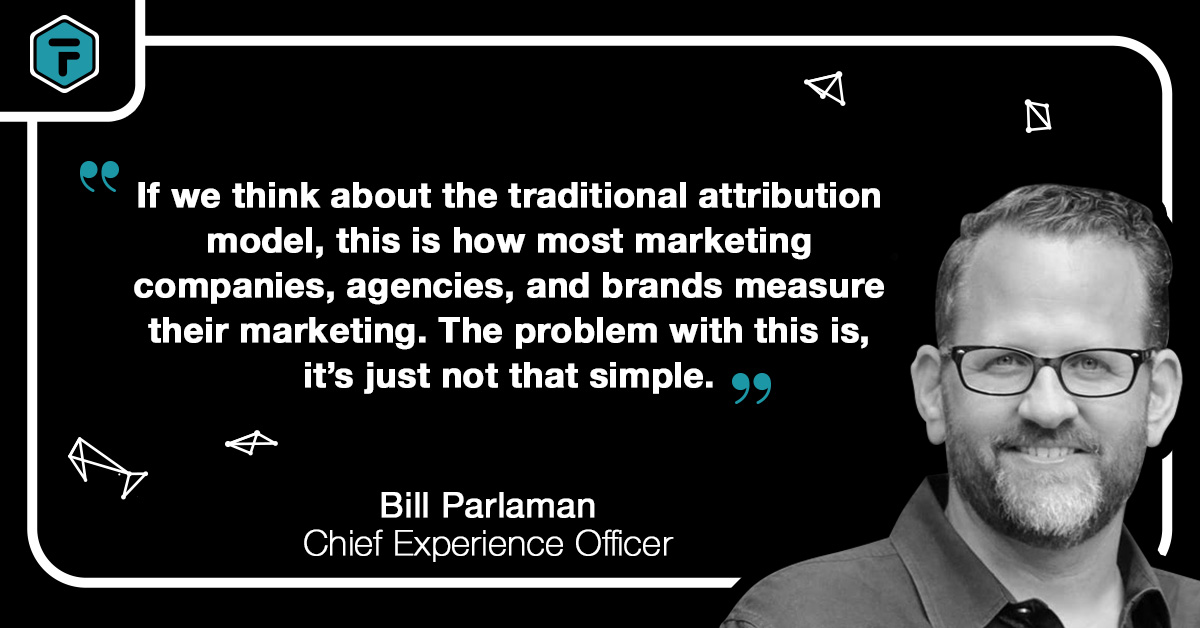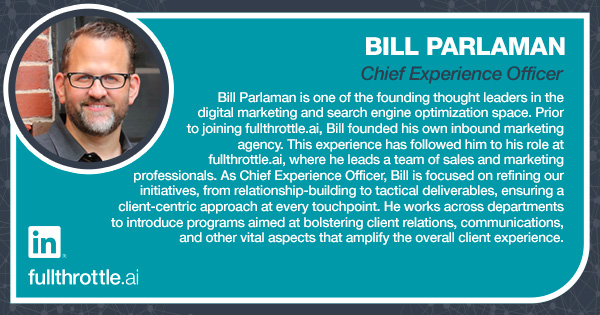
By Bill Parlaman, Chief Experience Officer
Old-School Marketing Attribution is Dead.
Attribution is the old way we used to do things in the world of marketing and there are a lot of reasons we did that. However as things change in the AdTech space and as marketers get smarter and understand how shoppers really shop, it’s important to evolve with technology changes as we get smarter.
Why do we need to know this?
The problem with old-school attribution—whether it’s single, first, last click, or even multiple attribution—the term itself can get a bit tricky.
One analogy we like to use at fullthrottle.aiTM is this. Let’s say one night, you decide to go drinking. You have three beers, a glass of wine, two whiskeys, and a few shots of tequila. That’s a lot to drink. The next morning, you wake up completely hungover and you might ask yourself which one of those drinks caused your terrible headache and sick stomach.
The problem is, there is no way of knowing which one of those drinks really caused it.
This applies the same way to your marketing.
Marketers, brands, and businesses try to figure out the one silver bullet or magic wand that helped create the sale. However, due to limitations with the way we track things and the way shoppers buy, this is not really possible.
This is the same with advertising. We really have no clue what closed the sale or even more importantly, what influenced a sale. We may know what the last thing someone did before making a purchase was, but in many cases, we have no idea what influenced them to get to that spot.
As marketers and businesspeople, we like to think that most people shop in a straight line. We think the process goes something like this:
- Bill is in market
- Bill sees an ad
- Bill clicks the ad
- Bill becomes a lead
- Bill purchases
So, if we think about the traditional attribution model, this is how most marketing companies, agencies, and brands measure their marketing. The problem with this is, it’s just not that simple.
People do not shop in a linear fashion.
Think about the last time you bought something.
Why Is The Traditional Attribution Model a Problem?
It is a problem for several reasons. I’ve broken it down into four.
Problem Number One
First, attribution allows for crediting teams and incentivizing results. Typically, marketing teams like showing how what they did worked. Many times, compensation can be tied to results. So, it is important for them to show last click and first click and prove how it helped drive that lead or that sale.
In other words, the better the results are, the more things they can take credit for in their marketing. Many teams are paid more for that and it’s easier, in the end, to create financial and incrementality reporting. At the end of the day, it is simpler for corporate teams to measure the buying journey in a straight line, since they report success in a straight, linear fashion.
However, as we know, there are many more channels to market. There are many more ways for people to see your messages, so many more screens, many more touches of influence. This is why marketers try to measure and attribute in a straight line.
Problem Number Two
The second part of this problem - that is not how everybody shops—as we mentioned earlier—and we all must remember there is no magic wand. There is no silver bullet that is going to find one thing that really works.
We believe this is why brands and marketing agencies try to find the “solution” that works or generates the most sales, so they can do more of that. However, when you think this way, you are marketing towards attribution as opposed to thinking about what influenced the shopper to make the sale.
We know businesses are looking for that magic wand or silver bullet, but they simply do not exist. There is not just one thing that helps generate sales. What we need to look for is that magical mix. We need to focus on finding the pieces that are really driving results.
It takes several incremental touchpoints before people can make a buying decision. Typically, five or six different influences help propel your buyer to make a decision.
If we go back to our example of going out and having multiple kinds of drinks and then trying to figure out what caused the hangover, we can compare this to an example of a boss asking a team to complete a task.
Let’s say Person A did the first part and Person B did the second part. Once that was completed, it was turned over to Person C. If Person C turned in the report and the boss said, “great work!” then the attribution is only to Person C. Meanwhile, Person A and B had a role in the project. So, this is how we need to think.
Problem Number Three
Thirdly, traditional tools, like Google and Adobe Analytics, aren’t enough to measure influences, as they only measure immediate conversion. For example, if you were to click on a retargeting ad and look at it but not purchase yet, then you later come back from somewhere else, there is no attribution or influence on the initial retargeting ad, as it wasn’t an immediate conversion.
It is important to keep in mind that Google and Adobe Analytics only tell a small part of the story. The whole story is important to get a sense of how multi-touch influence works.
Problem Number Four
Fourth, and to make matters worse, with the cookiepocalypse, you are currently only tracking about 50% of third-party cookies. At the end of 2023, when Chrome shuts down third-party cookies, it will be 0%. Marketing teams and brands are currently only capturing the low-hanging fruit in their marketing mix.
So, how do we solve these problems?
Let’s talk about the difference between how we have been marketing and how shoppers really shop.
I’ll use a real-life example.
Recently, I bought a product called a reMarkable and it’s a lifesaver for me. I am a little old-school and like to take notes. The issue with taking notes instead of typing them is that you end up with ten different notebooks and papers and Post-it Notes and run into the possibility of losing them - along with the issue of them not being organized.
One day, I saw an ad for the reMarkable. It feels just like paper and you can write your notes out, but it is a tablet. You can create folders and store and send notes and emails. It really was the answer to my prayers as far as taking notes and keeping handwritten notes all in one location.
It’s funny how it happened. The first time I learned about it, I didn’t know I needed it, since I wasn’t actively looking for it. I was scrolling through TikTok and sure enough, I saw an ad for a reMarkable. I figured it was pretty cool and made a mental note to check it out later. A couple of days, maybe a week later, I saw another ad on Facebook for it. Then, I saw an ad on Facebook Marketplace for the reMarkable—and then on my Instagram. This is a bit of a stretch, but I was in a meeting and a colleague had a reMarkable. I let them know I had been thinking about buying one but hadn’t done anything yet.
Boom. I got home from the business trip and within another couple of weeks, I got another ad. Sure enough, eventually I got another ad on Instagram. At this point, I go ahead and click on the ad and buy. This means my last click was Instagram, even though I first saw it on TikTok and then Facebook, and then a colleague with it.
reMarkable’s marketing team likely has no idea that all those different things combined influenced me. I am just one person. Imagine taking all that data and curating it and knowing your overall buyer's work.
The way a non-linear shopper’s journey is:
- Bill is near market or may not even be looking.
- Bill sees a national video ad and after seeing the ad, his buying propensity has increased.
- Bill sees an ad on TikTok and shrugs it off, thinking he does not have the time right now; he will think about it later.
- Then later, he sees another retargeting ad, followed by another national incentive ad.
- With interest rising, he clicked on the last ad, which had a sizable discount.
With each ad, I became more and more likely to buy. However, how are we measuring that? How do we know that it is really working?
With all of that said, it can sound complicated and overwhelming. So, what is the solution?
How Do We Start to Measure Influence Versus Attribution?
This is what we call adopting a multi-touch influence philosophy. One of our tools through our AdTech is providing multi-touch influence for businesses.
We can show people who visited the website. We can deanonymize that website traffic and capture their first and last name. We can identify households—the actual households where they were shopping. It is not IP-based and it’s not a mobile ID locator. It’s done latitude and longitude. A lot of other data points go in to help us understand.
Now, we can look at the influence. Here and then, we can tie it back to an actual sale. We can measure the entire influence of the buyer’s journey to actually match it back to a sale and a household. This gives our clients great insight into what’s working as far as their marketing mix goes.
This is why it is not about one silver bullet. It is about finding that magical mix.
How many days does it take from the time someone hits the website until the sale occurs? Some of this data can help clients craft a strategic marketing plan.
To find that mix, we need to stop chasing the magic wand. The key is to align your marketing objectives and key results around the cost-effective touchpoints with meaningful messages. There are many touchpoints.
Immersive Household Advertising
With fullthrottle.aiTM, we can see the entire magic mix through Immersive Household Advertising, with email, SmartMail, SmartVideo, SmartAudio, social media, addressable display, and addressable video. fullthrottle.aiTM has pioneered new methods to identify, curate and address relevant audiences which rely on its proprietary, patented technology. Say goodbye to old-school, outdated attribution today and schedule your demo to see fullthrottle.ai’s technology in action.


